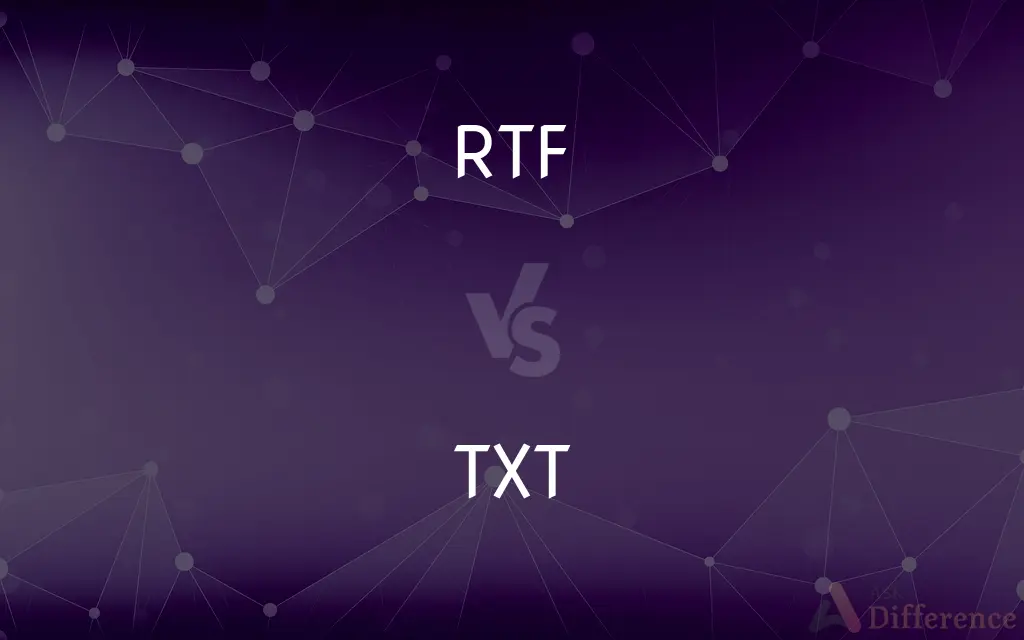RTF vs. TXT — What's the Difference?
By Tayyaba Rehman — Published on December 6, 2023
RTF (Rich Text Format) supports text formatting and styling, while TXT (plain text) holds unformatted, plain text.

Difference Between RTF and TXT
Table of Contents
ADVERTISEMENT
Key Differences
RTF and TXT are both file formats that store text-based data. RTF, or Rich Text Format, was developed by Microsoft in the 1980s and serves as a cross-platform document format. It allows users to save their documents with various formatting options like bold, italic, and underlining. On the other hand, TXT, short for "text," is a simplistic format that only saves the raw text data without any additional styling or formatting.
RTF files have the advantage of preserving the visual appearance of a document. This makes RTF suitable for more complex documents that contain images, tables, and formatted text. In contrast, TXT files strip all these features away, resulting in a file that has just the bare text, line breaks, and spaces. This straightforward nature of TXT files makes them universally readable on any platform or software that supports text.
In terms of file size, RTF files tend to be larger than TXT because of the additional information they carry related to formatting. TXT files, being devoid of any formatting instructions, are typically more lightweight. This means that for the same amount of textual content, an RTF file will generally be bulkier than its TXT counterpart.
While both RTF and TXT formats are widely recognized, RTF offers the flexibility to retain styling when shared between different word processing programs. This makes it a preferred choice for those who want to ensure their document appears the same everywhere. TXT, being universal and devoid of frills, is often used for configuration files, scripts, and other applications where plain text is essential.
In summation, RTF is tailored for those who need to maintain the formatting and style of their documents across different platforms and software. In contrast, TXT is the go-to choice for a simple, lightweight, and universally readable format.
ADVERTISEMENT
Comparison Chart
Formatting
Supports formatting (e.g., bold, italic)
No formatting, plain text only
File Size
Typically larger due to formatting data
Smaller, contains only raw text data
Universality
Cross-platform but requires specific readers
Universally readable on any text-supporting platform
Extension
.rtf
.txt
Use Cases
Documents with styling and formatting
Configuration files, scripts, basic notes
Compare with Definitions
RTF
A cross-platform document format supporting text formatting.
She saved the report as an RTF to keep the bold headings intact.
TXT
Universally compatible with any text-reading software or platform.
No matter the device, the TXT file opened seamlessly.
RTF
Typically larger in size than plain text files.
Considering its styling, the RTF file was understandably larger than the TXT version.
TXT
A file format containing unstyled, raw text.
The notes were saved as a TXT for universal readability.
RTF
Developed by Microsoft for rich text storage.
Microsoft introduced RTF as a bridge between different word processors.
TXT
Represents the simplest form of storing textual data.
For quick notes without any fluff, she always chose the TXT format.
RTF
Allows for the inclusion of images, tables, and styles.
The RTF document looked more vibrant with embedded images.
TXT
Stripped of all formatting and styling elements.
The TXT file showed the content in its most basic form.
RTF
Compatible with most word processing software.
Even though she used a different software, the RTF file opened without any issues.
TXT
Often used for scripts and configuration files.
He tweaked the game settings via the TXT configuration file.
TXT
(text messaging) text, text message
TXT
To text; to send a text message (to).
Common Curiosities
Is TXT better than RTF for sharing documents?
TXT is universal but lacks formatting. RTF retains styling but requires specific readers.
Why are RTF files generally larger than TXT files?
RTF files carry additional data related to text formatting and styles.
Can I open an RTF file in any text editor?
Most text editors can open RTF, but specific formatting might not be displayed correctly without appropriate software.
What is the main difference between RTF and TXT files?
RTF supports formatting and styling, while TXT is plain, unformatted text.
Which file format is better for scripting?
TXT is preferred for scripting due to its plain text nature.
Do all devices support TXT files?
Almost all devices with text-reading capabilities can open TXT files.
Can I add images to an RTF file?
Yes, RTF supports the inclusion of images.
Do TXT files support any formatting?
No, TXT files only contain plain text without any styling or formatting.
Can I convert an RTF file to TXT?
Yes, but converting RTF to TXT will remove all formatting.
When was RTF introduced and by whom?
RTF was developed by Microsoft in the 1980s.
Is TXT the simplest form of text storage?
Yes, TXT files store raw, unformatted text.
How do I recognize an RTF file?
It typically has an .rtf file extension.
Are TXT files more secure than RTF files?
Both can be opened easily, but TXT lacks macros, making it less prone to certain types of malware.
What happens if I rename the extension of an RTF file to TXT?
The file can still be opened, but specific RTF formatting might appear as raw code or be lost entirely.
Why might someone choose RTF over other rich text formats?
RTF is a cross-platform format that maintains consistency across different word processors.
Share Your Discovery

Previous Comparison
Oxidation Number vs. Valency
Next Comparison
Existentialist vs. NihilistAuthor Spotlight
Written by
Tayyaba RehmanTayyaba Rehman is a distinguished writer, currently serving as a primary contributor to askdifference.com. As a researcher in semantics and etymology, Tayyaba's passion for the complexity of languages and their distinctions has found a perfect home on the platform. Tayyaba delves into the intricacies of language, distinguishing between commonly confused words and phrases, thereby providing clarity for readers worldwide.
















































